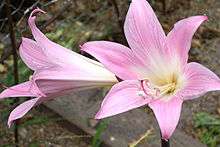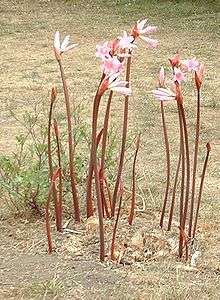Amaryllis belladonna
| Amaryllis belladonna | |
|---|---|
 | |
| Scientific classification | |
| Kingdom: | Plantae |
| Clade: | Angiosperms |
| Clade: | Monocots |
| Order: | Asparagales |
| Family: | Amaryllidaceae |
| Subfamily: | Amaryllidoideae |
| Genus: | Amaryllis |
| Species: | A. belladonna |
| Binomial name | |
| Amaryllis belladonna | |
| Synonyms[1] | |
|
Species synonymy
| |
Amaryllis belladonna,[2] (Jersey lily,[3] belladonna-lily, naked-lady-lily,[4] March lily[5]) is a plant species native to Cape Province in South Africa but widely cultivated as an ornamental. It is reportedly naturalized in many places: Corsica, Portugal, the Azores, Madeira, the Canary Islands, Zaire, Ascension Island, Australia, New Zealand, Mexico, Cuba, Haiti, the Dominican Republic, Chile, California, Texas, Louisiana, and the Juan Fernández Islands.[6][7]
Description
Perennial bulbous geophyte with one to two erect solid stems which appear in late summer. The inflorescence bears 2–12 showy fragrant funnel-shaped flowers on a 'naked' (leafless) stem, which gives it the common name of naked-lady-lily. The pink flowers which may be up to 10 cm in length, appear in the autumn before the leaves (hysteranthy) which are narrow and strap shaped.[4][5]
Taxonomy and etymology
Amaryllis belladonna is one of the two species in the genus Amaryllis as currently circumscribed.[8]
Belladonna is a Latin epithet meaning beautiful lady. There are many common names around the world, for instance in the Azores, Portugal one name is Meninas Para Escola (girls going to school) referring to the flowers blooming when the girls in their pink uniforms are starting the new school year.[5]
Habitat

In South Africa the plants are found growing among rocks.[5]
Cultivation
The bulbs are best planted just below the surface of the soil, with the neck of the bulb level with the surface. In colder climates mulching or lifting and overwintering is required. The bulbs may be propagated from offsets. Amaryllis bulbs require little watering and are drought tolerant.[4][5]
References
- ↑ Amaryllis belladonna, The Plant List
- ↑ Linnaeus, Carl (1753). Species Plantarum. 1. p. 293 – via Biodiversity Heritage Library.
- ↑ "BSBI List 2007". Botanical Society of Britain and Ireland. Archived from the original (xls) on 25 January 2015. Retrieved 2014-10-17.
- 1 2 3 RHS 2015.
- 1 2 3 4 5 Phipps 2011.
- ↑ "Amaryllis belladonna". Kew World Checklist of Selected Plant Families.
- ↑ "Amaryllis Belladona distribution map". Biota of North America Project.
- ↑ "Search for Amaryllis". World Checklist of Selected Plant Families. Royal Botanic Gardens, Kew. Retrieved 2015-02-01.
Bibliography
- RHS (2015). "Amaryllis belladonna: belladonna lily". Retrieved 1 April 2015.
- Dressler, S.; Schmidt, M. & Zizka, G. (2014). "Amaryllis belladonna". African plants – a Photo Guide. Frankfurt/Main: Forschungsinstitut Senckenberg.
- Carter, Kathie. "Amaryllis. Amaryllis belladonna (Brunsvigia rosea) and Hippeastrum hybrids" (PDF). Center for Landscape and Urban Horticulture. Cooperative Extension/Botany Plant Sciences Dept. University California Riverside. Retrieved 24 January 2015.
- Phipps, Nikki (9 February 2011). "Amaryllis Belladonna Planting – How To Grow Amaryllis Bulbs". Planting Flower Bulbs.
- Adams, T. (2001). "Amaryllis belladonna L." Plantzafrica. South African National Biodiversity Institute. Retrieved 2 April 2015.
| Wikimedia Commons has media related to Amaryllis belladonna. |
| Wikispecies has information related to Amaryllis belladonna |